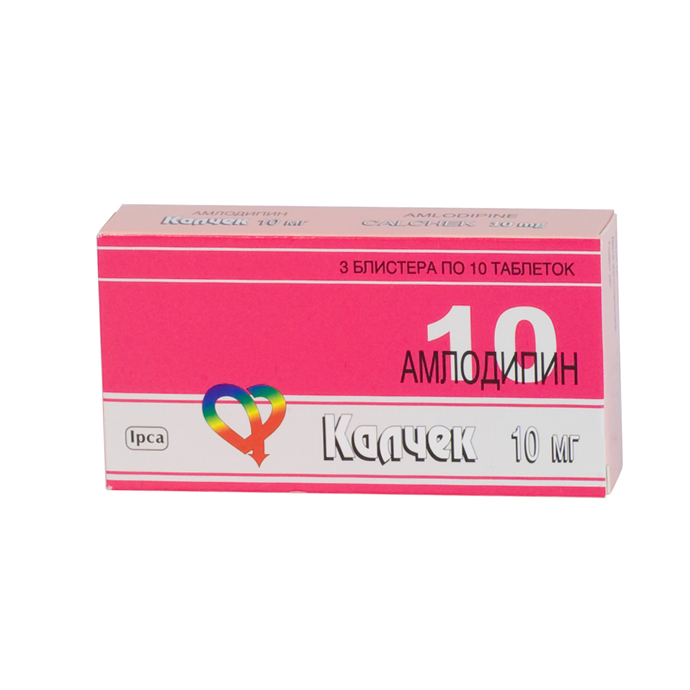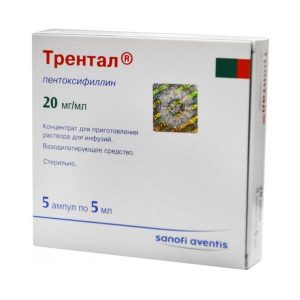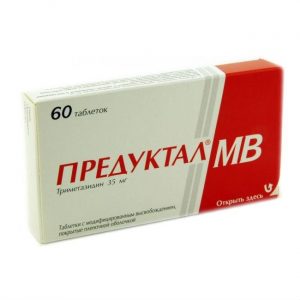Description
Release form
Tablets.
Packing
30 pcs.
Pharmacological action
Amlodipine is a derivative of dihydropyridine. By binding to dihydropyridine receptors, it blocks slow calcium channels, inhibits the transmembrane transition of calcium into the smooth muscle cells of the heart and blood vessels (more to the smooth muscle cells of blood vessels than to cardiomyocytes). It has a hypotensive and antianginal effect.
The mechanism of the hypotensive effect of amlodipine is due to a direct relaxing effect on the smooth muscles of blood vessels.
Amlodipine reduces myocardial ischemia in the following two ways:
1. It expands arterioles and, thus, reduces the overall peripheral resistance (afterload), while the heart rate remains almost unchanged, which leads to a decrease in energy consumption and myocardial oxygen demand.
2. Expands the coronary and peripheral arteries and arterioles in both normal and ischemic zones of the myocardium, which increases the oxygen supply to the myocardium in patients with vasospastic angina (Prinzmetal angina) and prevents the development of coronary spasm caused by smoking.
In patients with arterial hypertension, a single daily dose of Kalchek provides a decrease in blood pressure (BP) for 24 hours (both in the “lying” and “standing” positions). Due to the slow onset of action, amlodipine does not cause a sharp decrease in blood pressure.
In patients with angina pectoris, a single daily dose of the drug increases the time it takes to exercise, delays the development of another attack of angina pectoris and ST segment depression (by 1 mm) during exercise, and reduces the frequency of angina attacks and consumption of nitroglycerin.
Use in patients with coronary heart disease (CHD)
In patients with cardiovascular disease (including coronary atherosclerosis with damage to one vessel and up to stenosis of 3 or more arteries and carotid atherosclerosis) who have had myocardial infarction, percutaneous transluminal angioplasty arteries (TLP) or those suffering from angina pectoris, the use of Kalchek prevents the development of thickening of the intima-media of the carotid arteries, stroke, TLP, coronary artery bypass grafting, leads to a decrease in the number of hospitalizations for unstable angina and the progression of chronic heart failure (CHF), reduces the frequency of interventions aimed at restoring the coronary flow.
Use in patients with heart failure
Kulchek does not increase the risk of death or the development of complications and deaths in patients with chronic heart failure (CHF) of functional class III IV (NYHA) during treatment with digoxin, diuretics and ACE inhibitors. In patients with CHF III IV functional class according to TNRF of non-ischemic etiology, when Kalchek is used, there is a possibility of pulmonary edema. Kalchek does not have any adverse effect on the metabolism and concentration of blood plasma lipids.
Pharmacokinetics
After oral administration, amlodipine is slowly absorbed (about 90%) from the gastrointestinal tract. Absolute bioavailability is 64 80%, the maximum concentration in the blood serum is observed after 6 9 hours. Equilibrium concentrations are reached after 7-8 days of drug therapy. Eating does not affect the absorption of amlodipine. The average distribution volume is 21 l / kg body weight, which indicates that most of the drug is in the tissues, and a relatively smaller amount is in the blood.
Most of the drug in the blood (97%) binds to plasma proteins.
Amlodipine is metabolized in the liver to form inactive metabolites.
After a single oral dose, the elimination half-life (T1 / 2) averages 35 hours. About 60% of the ingested dose is excreted by the kidneys mainly in the form of metabolites, 10% – unchanged, and 20-25% – with bile through the intestine.
In patients with T1 / 2 arterial hypertension – 48 hours, in elderly patients (over 65 years old), amlodipine excretion is slowed down (T1 / 2 – 65 hours) compared with younger patients, however, this boundary has no clinical significance.
In patients with hepatic insufficiency, an extension of T1 / 2 is assumed, and with prolonged administration, the cumulation of the drug in the body will be higher (T1 / 2 up to 60 hours).
Renal failure does not significantly affect the kinetics of amlodipine.
The drug crosses the blood-brain barrier. With hemodialysis, it is not removed.
Contraindications
hypersensitivity to amlodnpine and / or other components of the Kalkchev drug, as well as to other dihydropyridine derivatives
severe arterial hypotension (systolic blood pressure less than 90 mmHg)
unstable angina pectoris (except for
aorta under 18 years of age (efficacy and safety not established).
Caution: impaired liver function, sinus node weakness syndrome (severe bradycardia, tachycardia), chronic heart failure of non-ischemic etiology (NYHA Class III ² IV functional class), hypotension, aortic stenosis, mitral stenosis, hypertrophic obstructive cardiomyopathy, acute heart attack myocardium (and within 1 month after), elderly age.
Use during pregnancy and lactation
The safety of the use of amlodipine during pregnancy has not been established, therefore, use during pregnancy is possible only if the benefit to the mother outweighs the risk to the fetus.
There is no evidence of excretion of amlodipine in breast milk.
However, it is known that other BMKK – derivatives of dihydropyridine, excreted in breast milk. If necessary, the appointment of amlodipine during lactation should decide on the termination of breastfeeding.
Special instructions
During treatment, monitoring of body weight and sodium intake, the appointment of an appropriate diet.
It is necessary to maintain dental hygiene and frequent visits to the dentist (to prevent soreness, bleeding and gingival hyperplasia).
The dosage regimen for elderly patients is the same as for patients of other age groups. With increasing doses, careful monitoring of elderly patients is necessary.
Despite the absence of a ² Ñwithdrawal ² Ñ syndrome in BMCC, a gradual dose reduction is recommended before discontinuation of treatment.
Amlodipine does not affect plasma concentrations of potassium, glucose, triglycerides, total cholesterol, low density lipoproteins, uric acid, creatinine and uric acid nitrogen.
Patients with low body weight, patients of short stature and patients with severe impaired liver function may require a lower dosage.
Efficacy and safety of the use of the drug Kulchek in hypertensive crisis has not been established.
Effect on the ability to drive vehicles and mechanisms
During treatment, care should be taken when driving vehicles and engaging in other activities that require concentration and speed of psychomotor reactions, due to the possibility of dizziness and drowsiness.
Composition
1 tablet contains: active ingredient: amlodipine besilate, which is equivalent to 10 mg amlodipine.
excipients: corn starch, calcium hydrogen phosphate, talc, colloidal silicon dioxide, sodium carboxymethyl starch, magnesium stearate.
Dosage and administration
Inside, the initial dose for the treatment of arterial hypertension and angina pectoris is 5 mg of the drug once a day. The dose can be maximally increased to 10 mg once a day.
With arterial hypertension, the maintenance dose may be 5 mg per day.
Dose changes are not required when given simultaneously with thiazide diuretics, beta-blockers, or angiotensin converting enzyme (ACE) inhibitors.
No dosage changes are required in patients with renal failure.
Dose adjustment is usually not required in patients with impaired liver function.
In elderly patients it is recommended to use a medium therapeutic dose, dose adjustment is not required.
Side effects
From the cardiovascular system: palpitations, marked decrease in blood pressure, peripheral edema (swelling of the ankles and feet), rarely – cardiac arrhythmias (bradycardia, ventricular tachycardia, atrial flutter), myocardial infarction, chest pain, orthostatic hypotension, vasculitis, very rarely – development or worsening of heart failure, extrasystole, migraine.
From the central nervous system: headache, dizziness, fatigue, sensation of heat and flushing of blood to the face, drowsiness, mood changes, cramps, rarely – loss of consciousness, hypesthesia, nervousness, paresthesia, peripheral neuropathy, tremor, vertigo , asthenia, malaise, fainting, insomnia, emotional lability, depression, anxiety, unusual dreams, very rarely – ataxia, apathy, agitation, amnesia.
From the digestive system: nausea, vomiting, epigastric pain, rarely – increased liver transaminases, hyperbilirubinemia, jaundice (due to cholestasis), pancreatitis, dry oral mucosa, thirst, hepatitis, flatulence, gum hyperplasia, constipation, diarrhea, anorexia, very rarely – gastritis, increased appetite.
From the hemopoietic organs: very rarely – thrombocytopenic purpura, leukopenia, thrombocytopenia.
From the respiratory system: shortness of breath, rhinitis, very rarely – cough.
From the genitourinary system: rarely – pollakiuria, painful urination, nocturia, sexual dysfunction (including decreased potency) very rarely – dysuria, polyuria.
From the skin: very rarely – xeroderma, dermatitis, purpura, impaired skin pigmentation.
Allergic reactions: pruritus, rash (including erythematous, maculopapular rash, urticaria), angioedema, erythema multiforme.
From the musculoskeletal system: rarely – arthralgia, muscle cramps, arthrosis, back pain, myalgia (with prolonged use) very rarely – myasthenia gravis.
Other: rarely – gynecomastia, gyneururicemia, increase / decrease in body weight, hyperglycemia, visual impairment, diplopia, conjunctivitis, eye pain, ringing in the ears, dyspnea, nosebleeds, increased sweating very rarely – cold, sticky sweat, parosmia, taste disorder sensations, violation of accommodation, xerophthalmia.
Drug interaction
Inhibitors of microsomal liver enzymes can be expected to increase the concentration of amlodipine in blood plasma, increasing the risk of side effects, and inducers of microsomal liver enzymes to decrease.
Unlike other BMCC, there is no clinically significant interaction with non-steroidal anti-inflammatory drugs, especially indomethacin.
Thiazide and loop diuretics, beta-blockers, verapamil, ACE inhibitors and nitrates enhance the antianginal and hypotensive effect of amlodipine.
Amiodarone, quinidine, inhalation anesthetics (hydrocarbon derivatives), alpha1-blockers, antipsychotics (antipsychotics) and BMCC can enhance the hypotensive effect.
Amlodipine does not affect the pharmacokinetic parameters of digoxin and warfarin.
Cimetidine: with the simultaneous use of amlodipine with cimetidine, the pharmacokinetics of amlodipine does not change.
With the combined use of amlodipine with lithium preparations, it is possible to increase the manifestations of their neurotoxicity (nausea, vomiting, diarrhea, ataxia, tremor, tinnitus).
Calcium preparations may reduce the effect of BMCC.
Antiviral agents (ritonavir) increase plasma concentrations of BMCC, including amlodipine.
Isoflurane – increased hypotensive effect of dihydropyridine derivatives.
With the combined use of BMCC with lithium preparations, an increase in neurotoxicity is possible.
Repeated use of amlodipine at a dose of 10 mg and atorvastatin at a dose of 80 mg is not accompanied by significant changes in the pharmacokinetics of atorvastatin.
Concomitant use of 240 ml of grapefruit juice and 10 mg of amlodipine is not accompanied by significant changes in the pharmacokinetics of amlodipine.
Concomitant use of 100 mg of sildenafil in patients with essential hypertension does not affect the pharmacokinetics of amlodipine.
Overdose
Symptoms: marked decrease in blood pressure, tachycardia, excessive peripheral vasodilation (risk of developing severe and persistent arterial hypotension, including shock).
Treatment: gastric lavage, appointment of activated charcoal (especially in the first 2 hours after overdose), maintenance of cardiovascular function, control of cardiac and pulmonary function, elevated limb position, control of circulating blood volume and diuresis. To restore the tone of the vessels – the use of vasoconstrictor agents (in the absence of contraindications to their use) to eliminate the effects of calcium channel blockade – intravenous administration of calcium gluconate. Hemodialysis is ineffective.
Storage conditions
Store in a dry, dark place at a temperature not exceeding 25 ° C.
Keep out of the reach and sight of children.
Shelf life
3 years.
Active ingredient
Amlodipine
Prescription conditions
pharmacy Prescription
dosage form
tablets
Possible product names
KALCHE 0, 01 N30 TABLES
Kalchek 10mg tab. X30 (R)
KALCHEK 10MG. No. 30 TAB.
FIST TAB. 10MG No. 30
KALCHEK TAB. 10MG No. 30 (01.08)




